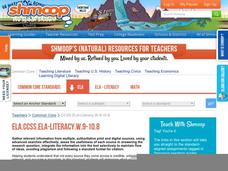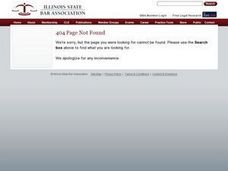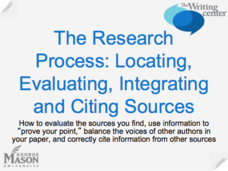Curated OER
Writing History: From Students to Scholars
An Online NewsHour article about scholarly ethics launches this study of plagiarism. Since historians are supposed to bring original ideas and perspectives to their publications, they must give credit to the ideas of others. After a...
Curated OER
The War of the Words
“Who’s This Guy Dylan Who’s Borrowing Lines From Henry Timrod?” The basic question in this lesson from the New York Time’s Learning Network is whether artists and authors who use the words of others are stealing from that artist or...
Shmoop
ELA.CCSS.ELA-Literacy.W.9-10.8
Demonstrate the importance of evaluating and citing sources. Pupils can complete the suggested assignment provided here, or one of your choosing, while focusing on checking that the resources are credible and citing those sources...
Curated OER
In-Text Citation
Wow! Here's a comprehensive look at the world of plagiarism. Types of plagiarism are defined, examples are shown, and in-text examples are highlighted. Being 75 slides long, this presentation is slightly overwhelming. Consider dividing...
Curated OER
Cite Right
What do you need to cite, and how can you avoid plagiarizing? This presentation is aimed at beginning writers, and it details some of the ways people plagiarize (even accidentally) and what sort of information needs to be cited. The best...
Curated OER
Understanding Plagiarism--Worksheet 1
Understanding plagiarism is the goal of this worksheet. After reading the two definitions of plagiarism listed on the sheet, class members decide whether the eight listed scenarios constitute plagiarism. Their responses are used to...
Curated OER
The Original's Sins
Are history textbooks plagiarized? The New York Times article, “Schoolbooks Are Given F’s in Originality,” looks at this question and forms the basis for a lesson on textbooks and plagiarism. The very detailed plan includes resource...
Curated OER
Cite Your Sites!
The New York Times article “Lessons in Internet Plagiarism,” launches a look at how the Internet has increased the prevalence of plagiarism. The richly detailed lesson includes warm-up and wrap-up activities, discussion questions,...
Curated OER
Plagiarism
Don't get caught plagiarizing! Before starting your research unit, use this lesson to help your young writers identify plagiarism. The truth is, many kids don't even realize when they're doing it! They practice citing sources when...
Curated OER
Plagiarism: Avoiding Accidental Internet Plagiarism
Demonstrate how to cite information from Internet sources without plagiarizing. If your class is working on an Internet research paper, and you have observed learners cutting and pasting directly from the Internet, the activities and...
Curated OER
Plagiarism Scenarios
A fresh take to teaching what plagiarism is! There are four scenarios described here, and your learners must decide which ones contain plagiarism and which ones do not. Use the activity to introduce the concept and get your class...
Curated OER
What is Plagiarism?
What is plagiarism? Middle schoolers create a class definition of plagiarism and examine the importance of crediting people for their ideas. They review official school policy on plagiarism and study the consequences of presenting the...
Curated OER
Plagiarism Worksheet
Explore plagiarism in-depth with this resource. Start by reading the short passage provided on Krumping, a new dance style. Then, study the examples provided to determine which ones plagiarise and which ones don't.
Southern Nevada Regional Professional Development Program
Focus: Writing a Brief Research Paper
If you are planning on working on a research paper in your class, take a look at this resource first. Starting off with information about plagiarism, the series of activities briefly described here should give your pupils a general idea...
Curated OER
The Research Process: Locating, Evaluating, Integrating, and Citing Sources
Planning on assigning a research project to a high school or college class? Although text-heavy, the concise explanations, color-coded examples, and writing tips included in this presentation make in worth a preview.
Curated OER
What is Plagiarism? Who Cares?
Who really cares if you plagiarize? Help your class recognize the importance of citing information correctly. Use this presentation to define plagiarism, citation, and common knowledge. Conscious and unintentional plagiarism are also...
Curated OER
Plagiarism
The definition for, consequences of, and how to prevent plagiarism is the subject of a presentation that also includes information on how to properly quote or paraphrase a source. Viewers can check their understanding with a series of...
Curated OER
Avoiding Plagiarism Worksheet
What exactly is plagiarism? Help your class recognize some of the related vocabulary terms with this two-page activity. Words like plagiarism, citing, and paraphrasing are included.
Curated OER
Those Baffling Bibliographies!
Are you working on a research and citation unit? Have your young writers listen to a lecture on how to cite research sources correctly and how to distinguish new information that requires citing. They compile a list of works cited from...
Curated OER
A Time Period in American History
Researchers combine music, narration, photos, and text to form a presentation for their classmates about a time period in American History. Proper research and documentation techniques are emphasized. The lesson, created by Apple...
Curated OER
What is Plagiarism?
A little redundant, this quiz nonetheless drives the point home: don't plagiarize! Nearly all questions are hypothetical scenarios followed by "Is this plagiarism?" Reinforce this notion through a quick quiz online.
Curated OER
Writing a Literary Analysis
What makes writing literary? What comprises analysis? A 15-slide PowerPoint presentation, created by the Purdue University Writing Lab, tackles these questions. The explanations of what makes writing literary and what comprises analysis...
Curated OER
Documenting Sources: An Introduction to Incorporating and Documenting Outside Sources in Your Writing
Text heavy, the 16 slides in this presentation provide specific examples to introduce researchers to documenting outside sources in expository writing. A follow-up activity or worksheet would provide an opportunity for guided practice.
Curated OER
Please No Posers
How do you reference information correctly? Avoid plagiarism by accurately summarizing a New York Times article with your middle or high schoolers. Young researchers then insert properly attributed quotations and paraphrases into their...

























